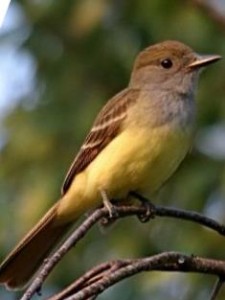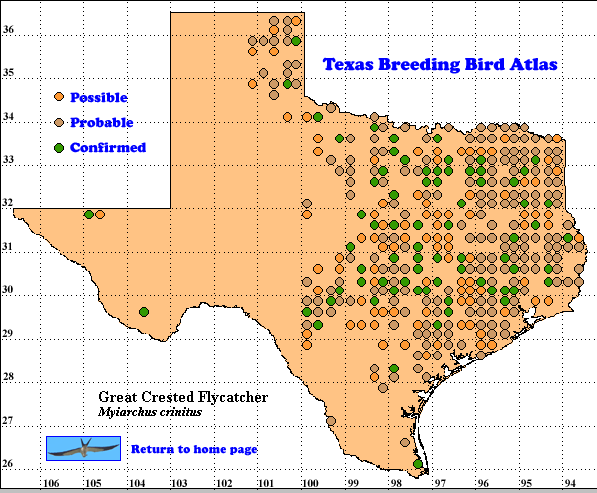The harsh calls of the Great Crested Flycatcher are more often heard than this secretive bird is seen. It is most often seen when sallying forth, bill snapping, to catch a flying insect or repel an intruder in its territory (Lanyon 1997).
The broad range of this species in Texas overlaps the ranges of the other three Myiarchus species found in this state, but hybridization has not been observed (Dixon 1989).
DISTRIBUTION. Data from the TBBA field work (1987-1992) show the Great Crested flycatcher to have the widest geographical range of the 4 Myiarchus species breeding in the state. Its range extends from the Guadalupe Mountains of the Trans Pecos to the Pineywoods on the Louisiana border. The areas of high concentrations on the map below are similar to the breeding areas on the maps of. Lockwood and Freeman (2004) and Oberholser (1974). Neither of these maps shows breeding in or around the Guadalupe Mountains and only Oberholser (1974) shows summer records from the Davis and Chisos areas.
North American Breeding Bird Survey (BBS) data from 94 routes on which the species was detected in Texas to be highest in the Pineywoods region where relative abundances were 3-10 flycatchers per 40 km (25 mi) route. The relative abundance decreased from there to <1 flycatcher per route west of the 97th meridian (Sauer et al. 2005).
Outside Texas Great Crested Flycatchers breed across southern Canada from Alberta to Nova Scotia and south to the Gulf Coast. They winter along both coasts of Middle America south of the Isthmus of Tehuantepec to central Panama and also in south Florida (Lanyon 1997).
SEASONAL OCCURRENCE. Great Crested Flycatchers migrate through Texas northbound from about March 9 to June 15 with most individuals present from late March or early April to mid-May. The species breeds from early April to early July, based on egg dates between April 30 and June 8 and young in the nest from April 18 to June 26. Southbound migrants are present from about June 26 to November 5 with most flycatchers moving through from late July or early August to late September. Most wintering records are from December in south Texas and along the coast and may represent lingering migrants (Oberholser 1974, Lockwood and Freeman 2004).
BREEDING HABITAT. Great Crested Flycatcher breeds in Texas from sea level to about 1000 m (3500 ft) in shady deciduous woodland fragments, orchards and parks (Oberholser 1974, Lanyon 1997).
The pair chooses a natural cavity in a live or dead tree or if one is not available, an abandoned woodpecker hole or a human-made cavity, usually 3-6 m )10-20 ft, range 1-23 m [3-75 ft]) above the ground. The cavity is filled with a bulky mass of twigs, leaves, hair, feathers and human detritus, sometimes including a cast-off snake skin or piece of cellophane.. Both parents built the nest, taking as long as 2 weeks, and line the small cup with fine materials and feathers.The cup diameter is 7-9 cm (2.7-3.5 in), depth 4-5 cm (1.5-2 in).
The female generally lays 5 (range 4-6) smooth, slightly glossy yellowish or pinkish white eggs, sometimes almost completely covered with dark markings. She incubates the eggs for 13-15 days and the young birds leave the cavity about 13-15 days after hatching. Brood parasitism is infrequent (Harrison 1979, Lanyon 1997).
STATUS. Lockwood and Freeman (2004) characterize Great Crested Flycatcher as a common. summer resident in eastern Texas. BBS data produce a statistically significant population trend of -2.2% change per year for the period 1966-2004. Across the United States and Canada 3190 BBS routes produce a 95% confidence interval (There is a 95% chance that the actual population trend will be between these two numbers.) of -0.3 to +0.3% population change per year for the same period (Sauer et al. 2005).
The data suggest that the status of Great Crested Flycatcher as a migrant in Texas is secure for the foreseeable future. Its status as a summer resident in the Pineywoods, where the relative abundance is the same as most of its large range, is probably also relatively secure.
Text by Robert C. Tweit (2005)
Literature cited.
Dixon, K. L. 1989. Contact zones of avian congeners on the southern Great Plains. Condor 91: 13-22.
Harrison, H. H. 1979. A field guide to western birds’ nests. Houghton Mifflin, Boston, MA.
Lanyon, W. E. 1997. Great Crested Flycatcher (Myiarchus crinitus). In The birds of North America, No. 300 (A. Poole and F. Gill, eds.). The Birds of North America, Inc., Philadelphia, PA.
Lockwood, M. W. and B. Freeman. 2004. The TOS handbook of Texas birds. Texas A&M University Press, College Station.
Oberholser, H. C. 1974. The bird life of Texas. University of Texas Press, Austin.
Sauer, J. R., J. E. Hines, and J. Fallon. 2005. The North American Breeding Bird Survey, results and analysis 1966-2004. Version 2005.1. USGS Patuxent Wildlife Research Center, Laurel MD (Web site, http://www.mbr-pwrc.usgs.gov/bbs).

